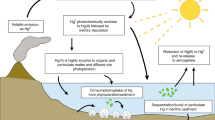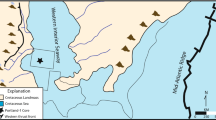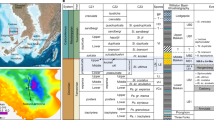Abstract
Recovery from the end-Permian mass extinction is frequently described as delayed1,2,3, with complex ecological communities typically not found in the fossil record until the Middle Triassic epoch. However, the taxonomic diversity of a number of marine groups, ranging from ammonoids to benthic foraminifera, peaked rapidly in the Early Triassic4,5,6,7,8,9,10. These variations in biodiversity occur amidst pronounced excursions in the carbon isotope record, which are compatible with episodes of massive CO2 outgassing from the Siberian Large Igneous Province4,11,12,13. Here we present a high-resolution Early Triassic temperature record based on the oxygen isotope composition of pristine apatite from fossil conodonts. Our reconstruction shows that the beginning of the Smithian substage of the Early Triassic was marked by a cooler climate, followed by an interval of warmth lasting until the Spathian substage boundary. Cooler conditions resumed in the Spathian. We find the greatest increases in taxonomic diversity during the cooler phases of the early Smithian and early Spathian. In contrast, a period of extreme warmth in the middle and late Smithian was associated with floral ecological change and high faunal taxonomic turnover in the ocean. We suggest that climate upheaval and carbon-cycle perturbations due to volcanic outgassing were important drivers of Early Triassic biotic recovery.
This is a preview of subscription content, access via your institution
Access options
Subscribe to this journal
Receive 12 print issues and online access
$259.00 per year
only $21.58 per issue
Buy this article
- Purchase on Springer Link
- Instant access to full article PDF
Prices may be subject to local taxes which are calculated during checkout


Similar content being viewed by others
References
Meyer, K. M., Yu, M., Jost, A. B., Kelley, B. M. & Payne, J. L. δ13C evidence that high primary productivity delayed recovery from end-Permian mass extinction. Earth Planet. Sci. Lett. 302, 378–384 (2011).
Payne, J. L. & Kump, L. R. Evidence for recurrent Early Triassic massive volcanism from quantitative interpretation of carbon isotope fluctuations. Earth Planet. Sci. Lett. 256, 264–277 (2007).
Wignall, P. B. The end-Permian mass extinction—how bad did it get? Geobiology 5, 303–309 (2007).
Brayard, A. et al. The Early Triassic ammonoid recovery: Paleoclimatic significance of diversity gradients. Palaeogeogr. Palaeoclimatol. Palaeoecol. 239, 374–395 (2006).
Brühwiler, T., Bucher, H., Brayard, A. & Goudemand, N. High-resolution biochronology and diversity dynamics of the Early Triassic ammonoid recovery: The Smithian faunas of the Northern Indian Margin. Palaeogeogr. Palaeoclimatol. Palaeoecol. 297, 491–501 (2010).
Hautmann, M. et al. An unusually diverse mollusc fauna from the earliest Triassic of South China and its implications for benthic recovery after the end-Permian biotic crisis. Geobios 44, 71–85 (2011).
Hofmann, R., Goudemand, N., Wasmer, M., Bucher, H. & Hautmann, M. New trace fossil evidence for an early recovery signal in the aftermath of the end-Permian mass extinction. Palaeogeogr. Palaeoclimatol. Palaeoecol. 310, 216–226 (2011).
Orchard, M. J. Conodont diversity and evolution through the latest Permian and Early Triassic upheavals. Palaeogeogr. Palaeoclimatol. Palaeoecol. 252, 93–117 (2007).
Song, H. et al. Recovery tempo and pattern of marine ecosystems after the end-Permian mass extinction. Geology 39, 739–742 (2011).
Beatty, T. W., Zonneveld, J. P. & Henderson, C. M. Anomalously diverse Early Triassic ichnofossil assemblages in northwest Pangea: A case for a shallow-marine habitable zone. Geology 36, 771–774 (2008).
Galfetti, T. et al. Late Early Triassic climate change: Insights from carbonate carbon isotopes, sedimentary evolution and ammonoid paleobiogeography. Palaeogeogr. Palaeoclimatol. Palaeoecol. 243, 394–411 (2007).
Payne, J. L. et al. Large perturbations of the carbon cycle during recovery from the end-Permian extinction. Science 305, 506–509 (2004).
Retallack, G. J. et al. Multiple Early Triassic greenhouse crises impeded recovery from Late Permian mass extinction. Palaeogeogr. Palaeoclimatol. Palaeoecol. 308, 233–251 (2011).
Mundil, R., Ludwig, K. R., Metcalfe, I. & Renne, P. R. Age and timing of the Permian mass extinctions: U/Pb dating of closed-system zircons. Science 305, 1760–1763 (2004).
Ovtcharova, M. et al. New Early to Middle Triassic U–Pb ages from South China: Calibration with ammonoid biochronozones and implications for the timing of the Triassic biotic recovery. Earth Planet. Sci. Lett. 243, 463–475 (2006).
Brayard, A. et al. Transient metazoan reefs in the aftermath of the end-Permian mass extinction. Nature Geosci. 4, 693–697 (2011).
Galfetti, T. et al. Smithian–Spathian boundary event: Evidence for global climatic change in the wake of the end-Permian biotic crisis. Geology 35, 291–294 (2007).
Hochuli, P. A. & Vigran, J. O. Climate variations in the Boreal Triassic—Inferred from palynological records from the Barents Sea. Palaeogeogr. Palaeoclimatol. Palaeoecol. 290, 20–42 (2010).
Hermann, E. et al. Climatic oscillations at the onset of the Mesozoic inferred from palynological records from the North Indian margin. J. Geol. Soc. Lond. 169, 227–237 (2012).
Joachimski, M. M. et al. Climate warming in the latest Permian and the Permian–Triassic mass extinction. Geology 40, 195–198 (2012).
Baud, A., Atudorei, V. & Sharp, Z. Late Permian and Early Triassic evolution of the Northern Indian margin: Carbon isotope and sequence stratigraphy. Geodinam. Acta 9, 57–77 (1996).
Korte, C. et al. Massive volcanism at the Permian–Triassic boundary and its impact on the isotopic composition of the ocean and atmosphere. J. Asian Earth Sci. 37, 293–311 (2010).
Galfetti, T. et al. Timing of the Early Triassic carbon cycle perturbations inferred from new U–Pb ages and ammonoid biochronozones. Earth Planet. Sci. Lett. 258, 593–604 (2007).
Hermann, E. et al. Organic matter and palaeoenvironmental signals during the Early Triassic biotic recovery: The Salt Range and Surghar Range records. Sediment. Geol. 234, 19–41 (2011).
Paton, M. T. et al. Late Permian and Early Triassic magmatic pulses in the Angara–Taseeva syncline, southern Siberian Traps and their possible influence on the environment. Russ. Geol. Geophys. 51, 1012–1020 (2010).
Isozaki, Y. Permo-Triassic boundary superanoxia and stratified superocean: Records from lost deep sea. Science 276, 235–238 (1997).
Ware, D., Jenks, J., Hautmann, M. & Bucher, H. Dienerian (Early Triassic) ammonoids from the Candelaria Hills (Nevada, USA) and their significance for palaeobiogeography and palaeoceanography. Swiss J. Geosci. 104, 161–181 (2011).
Galfetti, T. et al. Evolution of Early Triassic outer platform paleoenvironments in the Nanpanjiang Basin (South China) and their significance for the biotic recovery. Sediment. Geol. 204, 36–60 (2008).
Brühwiler, T., Bucher, H., Roohi, G., Yaseen, A. & Rehman, K. A new early Smithian ammonoid fauna from the Salt Range (Pakistan). Swiss J. Palaeontol. 130, 187–201 (2011).
Trotter, J. A., Williams, I. S., Barnes, C. R., Lécuyer, C. & Nicoll, R. S. Did cooling oceans trigger Ordovician biodiversification? Evidence from conodont thermometry. Science 321, 550–554 (2008).
Sun, T. et al. Lethally hot temperatures during the Early Triassic greenhouse. Science 388, 366–370 (2012).
Acknowledgements
We thank K. De Baets (School of Earth Sciences, University of Bristol, UK) and L. Kocsis (Institute of Mineralogy and Geochemistry, University of Lausanne, Switzerland) for advise on the analyses and discussions. We are much obliged to G. Roohi, K. ur-Rehman and A. Yaseen (Pakistan Museum of Natural History, Islamabad) for logistics and help in the field. M. Hebeisen is thanked for laboratory assistance, J. Neenan for correcting the English and B. Scheffold for drawings (all Palaeontological Institute and Museum, University of Zurich, Switzerland). We appreciate valuable comments from H. Weissert (Department of Earth Sciences, Swiss Federal Institute of Technology, Zurich) and A. Brayard (Biogéosciences, University of Burgundy, Dijon, France) that helped to improve the manuscript. Past and present support of the Swiss National Science Foundation (projects 135446 to H.B. and 120311/135075 to W.B.) is deeply acknowledged.
Author information
Authors and Affiliations
Contributions
Fieldwork in the Salt Range was carried out by D.W., E.S-H., H.B., P.A.H. and T.B. Preparation of samples was performed by C.R. and N.G. and phosphate samples were measured by T.W.V. Ammonoids were identified by D.W., H.B. and T.B.; conodont element determinations were carried out by N.G.; fish teeth identification was performed by C.R. The manuscript was mainly written by C.R., H.B. and N.G., with valuable contributions from all other authors.
Corresponding authors
Ethics declarations
Competing interests
The authors declare no competing financial interests.
Supplementary information
Supplementary Information
Supplementary Information (PDF 4642 kb)
Rights and permissions
About this article
Cite this article
Romano, C., Goudemand, N., Vennemann, T. et al. Climatic and biotic upheavals following the end-Permian mass extinction. Nature Geosci 6, 57–60 (2013). https://doi.org/10.1038/ngeo1667
Received:
Accepted:
Published:
Issue Date:
DOI: https://doi.org/10.1038/ngeo1667
This article is cited by
-
A Unitary Association-based conodont biozonation of the Smithian–Spathian boundary (Early Triassic) and associated biotic crisis from South China
Swiss Journal of Palaeontology (2022)
-
The PhanSST global database of Phanerozoic sea surface temperature proxy data
Scientific Data (2022)
-
Vegetation response to exceptional global warmth during Oceanic Anoxic Event 2
Nature Communications (2018)
-
Nitrogen and Carbon Isotope Data of Olenekian to Anisian Deposits from Kamenushka/South Primorye, Far-Eastern Russia and Their Palaeoenvironmental Significance
Journal of Earth Science (2018)



